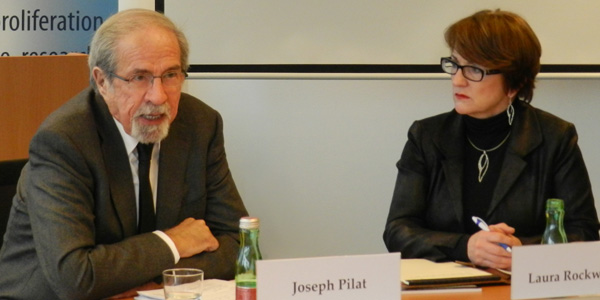

On 20 January 2016 the VCDNP hosted a seminar on the scientific, technical and political challenges of nuclear disarmament verification by Joseph Pilat, Program Manager in the Nuclear Security Office at Los Alamos National Laboratory (US) and Global Fellow at the Woodrow Wilson International Center for Scholars.
Dr. Pilat began by stating that the verification of disarmament was a "fundamental challenge" to making deeper cuts in nuclear arsenals and ultimately to achieving a nuclear-weapon-free world. Despite decades of research, the scientific community in the US and elsewhere still do not know how to verify nuclear warheads—which it is commonly assumed future arms control agreements will need to address, in ways they have never done before.
It is clear that the verification requirements of the future will be "unprecedented". Previous bilateral verification agreements focused on the verified dismantlement of delivery systems, rather than on the warheads they carry. Even the most recent US-Russian strategic nuclear arms control treaty, the New START (Strategic Arms Reduction Treaty) agreement, only touches upon warhead verification in a passing way. Dr. Pilat indicated that falling warhead numbers would make it "almost certain" that the focus of verification efforts will shift from delivery vehicles to the warheads themselves. However, the technical questions surrounding how warheads can be properly verified as part of any future arms control regime do not lend themselves to intuitive solutions.

Among a number of challenges, Dr. Pilat drew attention to problems of equipment 'authentication' (i.e. providing convincing proof that equipment works as declared, and only as declared) and 'initialization' (i.e. providing convincing proof that an item declared to be a warhead at the outset of a verified dismantlement process is indeed a warhead, not a fake). Both are problems that recur repeatedly in discussions and literature of nuclear warhead dismantlement. Indeed, that no good solutions have so far been found to the multiple challenges associated with dismantlement verification points, Dr. Pilat suggested, to a possible choice further down the road between continuing to invest in dismantlement verification research versus redirecting those efforts instead to support on-going research into means of verifying fissile material disposition. The latter, he admitted, comes with its own set of difficulties.
Dr. Pilat also noted that International Atomic Energy Agency (IAEA) safeguards will most likely need to continue to evolve in order to meet current and future disarmament-related challenges such as: the non-discriminatory application of safeguards in a nuclear weapon-free world; the need for improvements in nuclear material accountancy; the growing role of wide-area environmental sampling; and other methods of detecting possible clandestine facilities. He further noted that in a disarming and disarmed world the IAEA would need to be sure to use its authorities—including its traditionally seldom-used right to so-called special inspections—to their fullest extent.
In the end, despite the many challenges, Dr. Pilat struck a hopeful note, observing the possibilities for international collaboration. Such cooperation, he noted, was almost essential: "collaborative, international, multilateral" efforts on disarmament verification research—among not only nuclear-weapon states but non-nuclear-weapon states and non-governmental organizations besides—offered the best chance of finding solutions. Verification research, he added, could be seen as "building blocks" of progress towards disarmament that can be worked on even in the absence of political agreements.